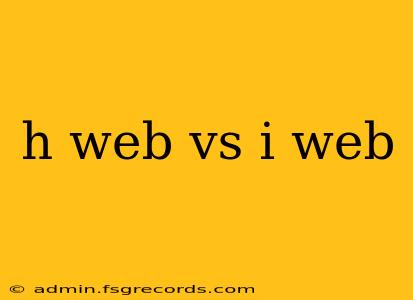The internet isn't static; it's constantly evolving. We've moved beyond the simple, read-only days of the early internet, and are now navigating a landscape shaped by user-generated content and decentralized technologies. Understanding the differences between Web 1.0, Web 2.0, and Web 3.0 is crucial for anyone seeking to grasp the internet's past, present, and future.
Web 1.0: The Read-Only Web (Early 1990s - Early 2000s)
Think static websites, primarily informational in nature. Web 1.0 was characterized by:
- Limited interactivity: Users primarily consumed information; there was little opportunity for participation or interaction. Websites were largely one-way communication channels.
- Static content: Websites were built with HTML, and content rarely changed unless manually updated.
- Focus on information dissemination: The primary goal was to make information available online.
- Examples: Early versions of websites like Yahoo! Directory, personal homepages, and simple online encyclopedias.
Web 1.0 laid the groundwork for the internet as we know it, but its limitations were clear. The lack of user engagement and dynamic content paved the way for the next generation of the web.
Web 2.0: The Social Web (Early 2000s - Present)
Web 2.0 ushered in an era of user-generated content, social interaction, and dynamic websites. Key characteristics include:
- User-generated content: Platforms like blogs, wikis, and social media enabled users to create and share content, fostering a sense of community and collaboration.
- Interactive and dynamic content: Websites became more engaging, utilizing technologies like AJAX and JavaScript to create richer user experiences.
- Social networking: Sites like Facebook, Twitter, and Instagram connected users globally, revolutionizing communication and information sharing.
- Mobile accessibility: The rise of smartphones and mobile internet access broadened the web's reach significantly.
- Examples: Facebook, YouTube, Twitter, Wikipedia, Blogs, and online forums.
Web 2.0 significantly increased user participation, but it also introduced challenges, such as data privacy concerns, the spread of misinformation, and the dominance of large tech companies.
Web 3.0: The Semantic Web (Present and Beyond)
Web 3.0 is still under development, but its core principles revolve around decentralization, artificial intelligence, and a more semantic understanding of data. Key features expected to define Web 3.0 include:
- Decentralization: A shift away from centralized platforms towards blockchain technology and decentralized applications (dApps), aiming to empower users and reduce reliance on big tech.
- Semantic web: Machines will better understand the meaning and context of data, enabling more intelligent and personalized online experiences.
- Artificial intelligence (AI) and machine learning (ML): AI will play a significant role in personalizing content, automating tasks, and enhancing user experience.
- Increased security and privacy: Blockchain technology and other cryptographic methods could improve data security and user privacy.
- Metaverse and Immersive Experiences: Integration of virtual and augmented reality technologies creates immersive online experiences.
- Examples: Cryptocurrencies, NFTs, Decentralized Autonomous Organizations (DAOs), and the Metaverse.
While the full realization of Web 3.0 remains to be seen, it holds the potential to address many of the limitations of Web 2.0, fostering a more democratic, secure, and user-centric internet.
Conclusion: The Continuous Evolution of the Web
The evolution from Web 1.0 to Web 3.0 represents a significant technological and societal shift. Understanding these distinctions provides valuable context for navigating the complexities of the modern internet and anticipating future trends. Each iteration has built upon its predecessor, improving functionalities and addressing inherent limitations, constantly reshaping how we interact with the digital world. The future of the web remains exciting and full of potential.

